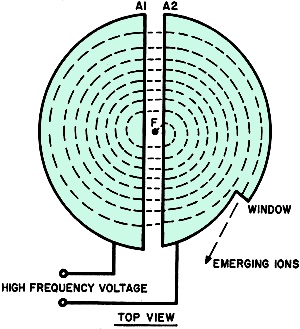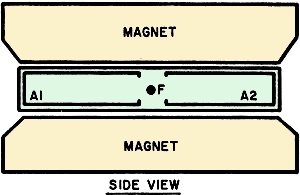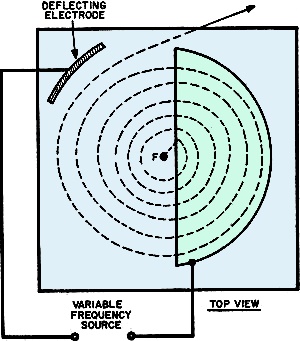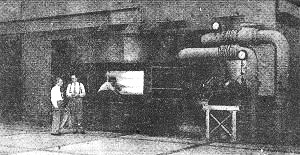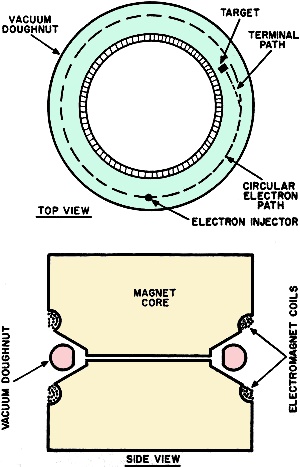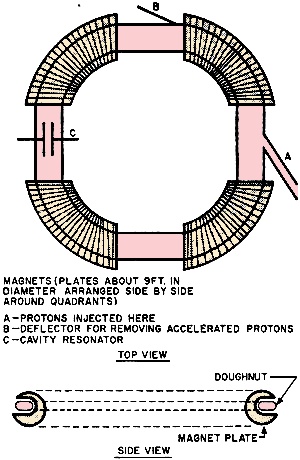After Class: Special Information on Radio, TV, Radar and Nucleonics
|
|||
By 1957, betatrons, cyclotrons, cosmotrons, synchrocyclotron, bevatrons, and other forms of "trons" had the physics world all agog with anticipation of the next big discovery. Quarks were still a decade away from being discovered and something as exotic as the Higgs boson (aka god particle) hadn't entered anyone's mind. The news media was agog with reports of the world possibly coming to the end as a result of those experiments sparking a nuclear reaction chain that would cause the whole world to explode. Today, the news media is no smarter, because nowadays they fret over the Large Hadron Collider (LHC) generating a black hole that will implode the whole world. What a ship of fools. After Class: Special Information on Radio, TV, Radar and Nucleonics The Particle Accelerators
Fig. 1. Fundamental cyclotron construction. Top view above, side view below.
Fig. 2. The synchrocyclotron. One dee is used instead of the two in the cyclotron.
Columbia University's huge synchrocyclotron produces alpha particle energies of over 400 million electron volts.
Fig. 3. The betatron. Note how the pole pieces go into the center of a vacuum "doughnut."
Fig. 4. Plan view of the Berkeley bevatron. Brookhaven's cosmotron follows a similar pattern. The cosmotron at Brookhaven. Concrete blocks in the foreground serve as shield; large "doughnut" is the magnet. I've begun to wonder where electron physics is going. There are so many different synchrotrons, betatrons, cosmotrons, etc., that the list seems endless. What are they all about and how do they work? We'll begin with the cyclotron, not because it was the first atom-smasher but because it was the granddaddy of all the modern particle "whirlers." The idea was to impart a very high velocity to an ion - to supply it with oodles of kinetic energy. Then it could be electrically directed to wallop an atom and blow it apart. Heavy positive particles like protons, deuterons (double protons), and alpha particles (two protons plus two neutrons) were selected as projectiles because their large masses help provide large impact energies. The Cyclotron. Dr. E. O. Lawrence and Dr. M. S. Livingstone built the first cyclotron (Fig. 1) in 1931. Picture a flat circular pill-box cut vertically down the middle - separated into two "D"-shaped halves. The hollow half-boxes or dees are connected across a source of high-frequency voltage and enclosed in a gas-filled chamber. The whole assembly is then mounted between the poles of a powerful magnet. An electrically heated filament in the position shown provides an abundance of electrons which serve to ionize the gas in the chamber. Suppose that at a given instant A1 is made positive with respect to A2 by the high-frequency voltage; a positive ion from the source F will be attracted toward A2, but instead of moving directly toward A2, it will move in a circular path due to the action of the uniform magnetic field produced by the pole pieces. As it reaches the gap between the two dees, it is accelerated by the strong electric field at this point and proceeds into the opposite box with increased velocity. If you whirl a stone attached to the end of an elastic band around your head, the stone will gyrate in ever-widening circles as you make it go faster and faster. So it is with the speeding particle; each time it crosses the gap, it is given another violent kick which causes it to spiral outward with more and more speed until at last it emerges from the "window" endowed with tremendous kinetic energy. Its target may be a cloud chamber or a photographic emulsion in which the effect of its atom-disruption may be observed and measured. The first cyclotron accelerated protons to a little over 1 million electron-volts (1 m.e.v.) of energy. (An electron-volt is the kinetic energy acquired by any particle carrying one unit of electric charge when it has been accelerated through one volt of potential.) As larger cyclotrons were built, the available particle energy rose steadily until, in 1946, the cyclotron peak of 40 m.e.v. for alpha particles was obtained. The limit was achieved at 40 m.e.v. because one of the famous scientific principles finally proved by Dr. Albert Einstein began to push its insistent proboscis into the picture: as any body moves at increasing speed, its mass also increases. Up to about 40 m.e.v., this increase in mass is very slight and does not affect the cyclotron's operation; beyond this energy value, however, the ions begin to gain mass. This slows them down enough so that their spiral paths fall out of synchronization with the high-frequency voltage on the dees and they no longer receive their accelerating shoves at the right instant. Synchrocyclotron To compensate for the increasing mass of the whirling protons or alpha particles, the frequency of the accelerator voltage can slowly be changed so that it keeps step with the diminishing speed increment of the ions. In 1950, the huge Columbia University synchrocyclotron went into operation using this synchronization principle. The most significant departure in construction from prior cyclotrons was the use of a single rather than a double dee. In the synchrocyclotron, a grounded deflecting electrode of simpler construction serves as the second side of the applied high-frequency voltage. Recent reports indicate that the Columbia synchrocyclotron produces alpha particle energies in excess of 400 m.e.v. An ion having this energy travels at approximately 93,000 miles per second or at a speed high enough to carry it to the sun in about 10 seconds flat! Thus far, no mention has been made of electrons, since the cyclotron and syn-chrocyclotron are positive-charge accelerators. Why can't they be used for accelerating electrons? If we remember that an electron has a rest mass of about 1/1800th that of a proton, it is evident that we would have to speed it up far more than a proton to obtain the same kinetic energy from it. (Kinetic energy depends upon both mass and velocity. If we want a large k.e. in a body of small mass, the velocity must be made very much greater.) To get an electron up to an energy level of only 1 m.e.v., we must make it travel at a speed more than nine-tenths that of light! At this velocity, its mass increases 2.5 times over its rest mass, and even a modern synchrocyclotron cannot compensate for such a large increase. Hence, it became apparent that another type of machine was required. The Betatron. The first successful betatron - the "beta" prefix comes from beta rays which are streams of electrons - was designed and built by D. W. Kerst in the United States in 1940. Its operation is similar to that of an ordinary step-up transformer. As illustrated in Fig. 3, the major features of the betatron include a large electromagnet whose pole pieces protrude into the center of an evacuated glass-tube "doughnut." Electrons are produced out-side the betatron by thermionic methods and are given a preliminary acceleration by an external electric field of about 50,000 volts potential. They are then fed or injected into the doughnut. The current through the electromagnet coils is alternating so that the magnetic field is a varying one; the injection process occurs at the precise time when the magnetic field is building up in the right direction. The effect of the field is to induce a voltage within the doughnut which increases the energy of the electrons. Although the electrons tend to spiral outward as their velocity increases, the magnetic field grows at exactly the right rate to counterbalance this tendency. It will be remembered that the field of the cyclotron is steady and that the spiral path is characteristic of such an unchanging magnetic flux. Thus, the electrons in the betatron follow essentially circular paths. The magnetic field around the doughnut is allowed to grow for only one-quarter of the a.c. cycle, but during this brief interval each injected electron makes over 275,000 turns around the circle! In the General Electric betatron, the magnet weighs 135 tons and the electrons cover a distance of about 900 miles before being ejected at an energy of 100 m.e.v. Each electron at ejection is traveling at a speed of more than 99.99% of the speed of light and has a mass nearly 200 times its rest mass! Bevatron or Cosmotron. How much further can we go? Right now in Birmingham, England, at the Brookhaven National Laboratory on Long Island, and in the Berkeley Radiation Laboratory, they are breaking the "m.e.v. barrier" every day. The newest of the atom smashers, a proton synchrotron called the "bevatron" at Berkeley and the "cosmotron" at Brookhaven, is at work whipping protons up to fantastic energies in the billion electron-volt region (b.e.v.'s). The proton synchrotron really combines the functions of a cyclotron and a betatron. Protons are first accelerated by a cyclotron and are then injected at A in Fig. 4. They are further accelerated by a varying magnetic field as in the betatron. As soon as the magnet becomes saturated, the betatron part of the operation ceases, and further acceleration is then produced by a high-frequency voltage applied to electrode C. This electrode, known as a cavity resonator, therefore performs a function similar to the dees in the cyclotron. The output of the Berkeley bevatron consists of a series of pulses at intervals of about six seconds from the 10,000-ton magnet. During each pulse a proton travels 270,000 miles - a distance greater than that to the moon! The average energy output of the Berkeley bevatron is on the order of six billion electron-volts! Where will it all end? The scientist has an insatiable thirst for knowledge and the boundless energy to see it through. Man, in his quest for the keys to the universe, has already duplicated the energy of cosmic rays in his new atom-smashers and has surpassed the heat of the sun in his nuclear bombs. Can we doubt that next will come the "trevatron," and then the "quadrevatron," and then - who knows?
Posted December 30, 2019 "After Class" Topics
|
|||

